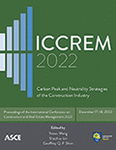Calculation and Forecasting of Carbon Emissions from the Construction Industry in Hebei Province
Publication: ICCREM 2022
ABSTRACT
The construction industry is the key sector to reduce emissions because of its contributing about 30%–40% of the global total GHG emissions all over the world, and also cause a great amount of GHG emissions from related industries. China will peak its carbon emissions before 2030. The GHG emissions of Hebei Province have been in the front rank although the region of Beijing-Tianjin-Hebei has developed coordinately and greenly since 2015. Based on the economic data from 2005 to 2020, the carbon emissions of the construction industry are calculated and analyzed by the input-output method and predicted for Hebei Province from 2021 to 2035 with three scenarios. The results show that it is difficult to realize the goal of carbon-reduction in 2025, and it will be a great challenge to achieve carbon peak for Hebei Province before 2030 with the existing development paradigm and industrial structure.
Get full access to this article
View all available purchase options and get full access to this chapter.
REFERENCES
BSI. (2016). PAS 2080: Carbon management in infrastructure. Her Majesty’s Stationery Office, London, UK.
Chuai, X., Huang, X., Lu, Q., Zhang, M., Zhao, R., and Lu, J. (2015). “Spatiotemporal changes of built-up land expansion and carbon emissions caused by the Chinese construction industry.” Environmental Science & Technology, 49(21), 13021–13030.
Hong, J., Shen, G. Q., Feng, Y., Lau, W. S. T., and Mao, C. (2015). “Greenhouse gas emissions during the construction phase of a building: A case study in China.” Journal of cleaner production, 103, 249–259.
Heibei Development and Reform Commission. (2020). “Performance of energy-saving and consumption reduction in Hebei Province in 2019.” <http://www.cznews.gov.cn/newweb/news/shengshi/2020-07-04/29250.html> (Apri 30, 2022). (in Chinese).
IPCC. (2014). Climate Change 2014: Synthesis Report. Contribution of Working Groups I, II and III to the Fifth Assessment Report of the Intergovernmental Panel on Climate Change IPCC, Geneva, Switzerland.
IPCC. (2021). Climate Change 2021: The Physical Science Basis. Contribution of Working Group I to the Sixth Assessment Report of the Intergovernmental Panel on Climate Change, Cambridge University Press, Cambridge, United Kingdom and New York.
Li, D., Huang, G., Zhang, G., and Wang, J. (2020). “Driving factors of total carbon emissions from the construction industry in Jiangsu Province, China.” Journal of Cleaner Production, 276, 123179.
Qi, S., and Zhang, Y. (2013). “Research on influencing factors and reduction strategies of carbon emission of construction industry in China.” Soft Science, 36(19), 77–79. (in Chinese).
Shang, C., Zhang, Z., and Li, X. (2010). “Research on energy consumption and emission of life cycle of expressway.” Journal of Highway and Transportation Research and Development, 8, 149–154. (in Chinese).
IEA and Global ABC (International Energy Agency and Global Aliance for Buildings and Construction). (2018). The report was coordinated by the United Nations Environment Programme and was made possible by the generous support of the governments of France, Germany and Switzerland.
Weng, Z., Ma, Z., Ge, C., Cai, S., Cheng, C., and Du, Y. (2019). “Projection on energy demand and carbon emission in various economic developing pathways: A case study in Hebei province.” China Environmental Science, 39(08), 3508–3517. (in Chinese).
Yuan, X. C., Sun, X., Zhao, W., Mi, Z., Wang, B., and Wei, Y. M. (2017). “Forecasting China’s regional energy demand by 2030: A Bayesian approach.” Resources, Conservation and Recycling, 127, 85–95.
Zhang, Z., and Liu, R. (2013). “Carbon emissions in the construction sector based on input-output analyses.” Journal of Tsinghua University Science and Technology, 53(1), 53–57. (in Chinese).
Zhao, D. L., Liu, Y. S., and Liu, S. S. (2020). “Decoupling situation of carbon emissions and the decoupling potential in China’s regional construction industry.” Journey of Building Energy Efficiency, 48(06), 105–111. (in Chinese).
Information & Authors
Information
Published In
History
Published online: Dec 15, 2022
Authors
Metrics & Citations
Metrics
Citations
Download citation
If you have the appropriate software installed, you can download article citation data to the citation manager of your choice. Simply select your manager software from the list below and click Download.
